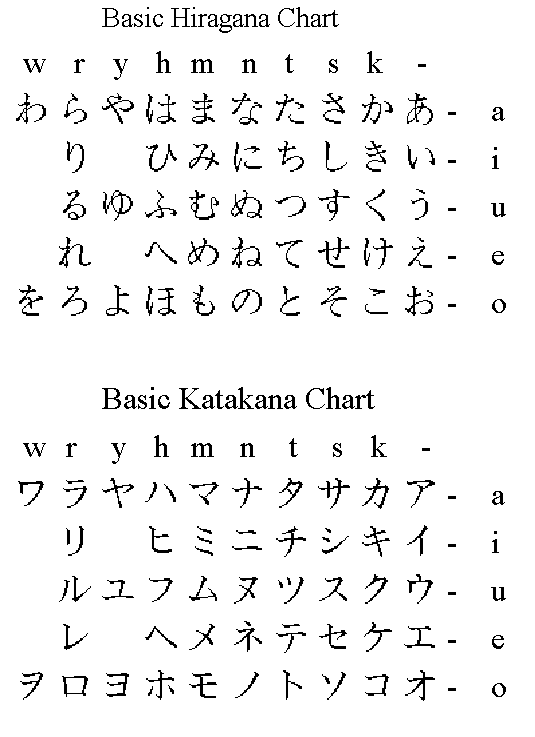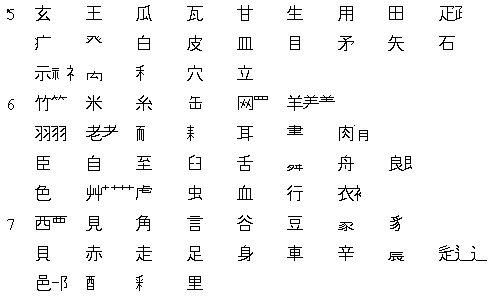 Asian Language Terminology
Asian Language Terminology Asian Language Terminology
Asian Language TerminologyChinese uses three basic symbol sets: pinyin, bopomofo, and hanzi.
 Hanzi (hahn-tzuh)
is Chinese for "Chinese (han) characters (zi)." Hanzi
originated in China approximately 4000 years ago, and over 50,000
hanzi have been used and cataloged. Currently, Chinese writing
uses about 6000 of these characters, with the other characters
used only rarely (as in rare proper names).
Hanzi (hahn-tzuh)
is Chinese for "Chinese (han) characters (zi)." Hanzi
originated in China approximately 4000 years ago, and over 50,000
hanzi have been used and cataloged. Currently, Chinese writing
uses about 6000 of these characters, with the other characters
used only rarely (as in rare proper names).
Three distinct forms or styles of hanzi exist: traditional, simplified, and handwriting style. The traditional hanzi character set is used currently in Taiwan and Hong Kong. The simplified character set is used in mainland China: the characters were systematically modified and simplified after the revolution with the idea of making reading and writing accessible to a broader spectrum of the population. The handwriting style is a complication of the simplified or traditional characters, with additional connecting strokes resulting from not lifting the pen or brush from the paper between strokes.
It is generally considered advantageous to learn the traditional forms first, the individual characters being more distinctive, then move onto the simplified characters after familiarity has been attained. However, many current and popular textbooks teach only simplified characters. Smart Characters supports both traditional and simplified characters.
Bopomofo (boe-poe-moe-foe) is the common name (like ABC) for the traditional Chinese phonetic syllabary consisting of 37 phonetic characters and 4 tone markings. Tones indicate the pitch at which a syllable is uttered (English uses tones to indicate emphasis, a question, irony, etc., but not spelling). Bopomofo is used to indicate the pronunciation of a hanzi, but is not used alone to make sentences. Bopomofo is taught and used in Taiwan and Hong Kong.
Pinyin (pin-een) is a way to write Chinese pronunciations using Roman characters (the English alphabet). For example, the Smart Characters logo, zher4 zi4 (4 means the 4th, falling tone), is more closely pronounced "jerr tzuh." The alternate Yale and WadeGiles systems give closer pronunciations when pronounced by English speakers. Even though Chinese sounds only roughly correspond to the English pronunciation of pinyin, the advantage of pinyin is that it closely corresponds to the bopomofo writing system, and that it is the standard phonetic system used in (mainland) China.
During Chinese word processing, words are entered phonetically using pinyin on a standard PC keyboard. These syllables may, optionally, appear on the monitor as bopomofo, and be converted to hanzi by a subsequent function. Because of wide variations in dialects, text entry based on phonetics presents particular problems for Chinese who do not know standard "spellings." Many Chinese must use alternative text entry methods based on a character's form or shape, rather than its pronunciation.
Unlike English and Chinese, which use one character set each, written Japanese intermixes three different types of characters or symbols: kanji, hiragana, and katakana. Additionally, English names, words, phrases, and numbers may be used freely in a Japanese sentence. Separately, Japanese may be transliterated into the English alphabet. Such writing is called romaji (roman characters).
Kanji (kahn-gee) is Japanese for "Chinese (kan) characters (ji)." These characters originated in China approximately 4000 years ago, and were imported into Japan, where they were adapted to the Japanese spoken language. Consequently, kanji are very close to the Chinese hanzi and share many identical characters, although they are pronounced differently (e.g., "kan" instead of "han," and "ji" instead of "zi"). Kanji are sometimes (loosely) called ideograms as they generally represent ideas or objects, although they are frequently used only phonetically. The other Japanese characters sets - hiragana, katakana, and romaji - are exclusively phonetic. Some words consist of just one kanji, although most words consist of combinations of kanji and hiragana.
Although tens of thousands of kanji have been used in the past, currently only 2000 or so are used in everyday language. Nevertheless, mastering the use of kanji is extremely difficult. Besides the necessity of memorizing large numbers of kanji, individual kanji adopt different meanings and pronunciations depending on their juxtaposition within a sentence or word. In Japan, the number of kanji a person knows and uses reflects his or her education.

Hiragana (he-hrah-gah-nah) is comprised of 46 phonetic symbols. Each hiragana character represents a specific sound or combination of sounds used in Japanese. In English, this type of character set is called a syllabary.
Every Japanese word can be written phonetically in hiragana. However, since Japanese contains so many words with the same pronunciations, to avoid confusion, kanji are often used in place of hiragana to clarify meaning. Hiragana is also used to write words not derived from the traditional Chinese characters, or in place of kanji which have been dropped from everyday use, or when the number of kanji in a sentence becomes so great as to be visually unaesthetic, or makes the author seem "bigheaded."
A miniaturized version of hiragana called furigana (fooreegahna) are placed in close juxtaposition to a kanji to provide phonetic guidance to the kanji's pronunciation. Furigana are the Japanese pronunciation annotations described in the media release. Smart Characters allows the user to display furigana either above or below the kanji, hide them, or, amazingly, display kanji as hiragana.
Katakana (kah-tah-kah-nah) is a separate phonetic syllabary somewhat analogous to italics in English. There is a onetoone correspondence between the hiragana and katakana syllabaries. Katakana is used to denote foreign or emphasized words.
Romaji (roe-mah-gee) is a way to write Japanese words phonetically using Roman symbols (the English alphabet). In essence, the English alphabet is used phonetically in place of hiragana, katakana, and kanji. Romaji is analogous to Chinese pinyin.

Japanese word processing begins with the user typing romaji on a standard PC keyboard. The romaji are converted to the corresponding hiragana or katakana, and inserted into the text. Optionally, the user converts hiragana words to kanji by selecting from a list of kanji with matching pronunciations. Alternatively, the computer can automatically substitute plausible kanji into a sentence, but even the most sophisticated software makes frequent mistakes.
Over the course of human events, tens of thousands of unique Chinese characters (kanji in Japanese, hanzi in Chinese) have been created. When written by hand, each character is drawn with a series of brush or pen strokes. Characters contain from 1 to 33 (or more) strokes. The traditional order of the strokes in a figure (which line is drawn first, second, etc.) is firmly and absolutely fixed, and native school children are allowed no deviation from correct stroke order.
Simple characters consist of one distinct figure, while more complex characters combine simple figures into a compound that combines the meanings of its components (one component may be used for pronunciation without adding meaning). All Chinese characters have a specific meaning when used alone, although they are frequently used in combination with other characters to form words related to the meanings of the individual characters.
Unlike words written in alphabetic languages, the pronunciation of Chinese characters is not self evident. Nor is there a simple and obvious "order" to the characters. These two facts make looking up Chinese characters in a dictionary a nontrivial task.
Although characters can be and are ordered on the basis of the number of strokes in the character, the large number of characters with, say, 27 strokes (about 400) makes it hard to locate a character without a secondary order. Additionally, small differences (e.g., the inclusion or removal of a dot) changes the stroke count, and similar characters end up far apart in a stroke order dictionary.
As Chinese writing evolved, and increasing numbers of Chinese characters were created, the difficulty of cataloging led to the selection and stylizing of approximately 1000 components in frequent use. Two hundred twelve of the most common components, called radicals, were selected to represent categories of Chinese characters. A character that contains a radical belongs to that radical group. If a character contains more than one radical component, it usually belongs to the most dominant radical group, although there are exceptions...

The traditional radicals are ordered according to the number of strokes in the radical. In a Japanese or Chinese radical and stroke dictionary, the Chinese characters (kanji or hanzi) are arranged in traditional radical order. Under each radical, characters are arranged according to the number or strokes required to draw the remainder of the character (excluding the radical). For example, under a radical, all the characters that can be drawn with that radical and 8 additional strokes are listed. Remember that these 8 pen or brush strokes can be combined in different combinations, giving rise to a number of different characters. After all the 8 stroke characters have been listed, then all the characters that can be drawn with that radical and 9 strokes are listed, etc. Hence the term radical and stroke.
Radical and stroke dictionaries frequently have a supplementary list that inventory characters by stroke and radical, for those who cannot correctly identify a character's radical.
Although radical and stroke lookup is used primarily to identify a character to yield its pronunciation, radical and stroke dictionaries also typically list words that begin with the character. However, words that use the character as the second or subsequent character are omitted from such a list.
Smart Characters searches all syllable, user, and word and phrase dictionaries for the character to yield definitions, pronunciations, and examples of usage regardless of the character's position in a word.
Copyright © 1996 Apropos, Inc.